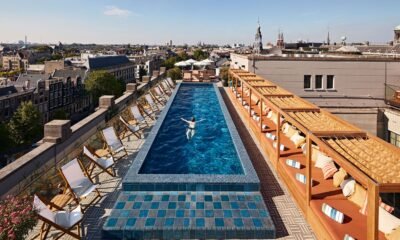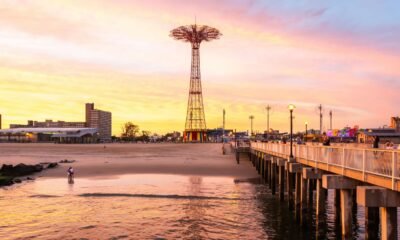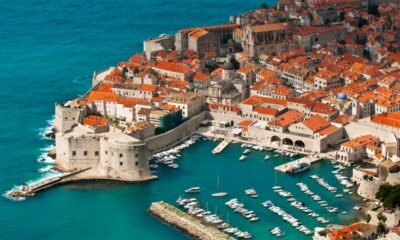Solo Travellers
A Guide to New York’s Catskills, for Nature, Art, and Boutique Hotels

Just 120 miles north of Manhattan, the Catskills offer a dreamy escape where nature, history, and artistic soul collide. Rolling farmland, dome-shaped peaks, and postcard-worthy towns set the stage for a region rich in both history and creativity. Scenic hikes lead to hidden swimming holes, roadside farm stands spill over with local produce, and the coziest diners serve up hearty, seasonal fare. In winter, slopes at Windham and Hunter lure skiers in; whereas summer plans call for exploring streams and trails, inviting lazy afternoons and wildflower walks.
From Woodstock to Phoenicia, each town offers its own flavor, with colorful streets, farm-to-table restaurants, and a laid-back but cheerful vibe. Long a magnet for artists and free spirits—Bob Dylan, Janis Joplin, and Mark Twain, to name a few—the region still buzzes with a creative pull (now, of course, just more contemporary). The dynamic blend of creative urban transplants and nature lovers has amped up the region’s ever-growing innovation. And today, chic lodges, hotels, and Airbnbs nestle into colorfully restored villages, while boutique shops and contemporary galleries showcase a vibrant presence of local talent. The Catskills’ charm is undeniable, with its mix of culture, adventure, and natural wonder. Read on for where to eat, stay, and play when you’re headed this way.
Jump to:
FAQ:
How do I get to the Catskills?
Though much of this corner of New York is unfortunately not directly accessible by major train lines, stops along the Metro-North and Amtrak lines lead to many close-by towns in the bordering region of the Hudson Valley. From there, it’s best to venture into the Catskills by car.
When is the best time to visit the Catskills?
The Catskills are a year-round destination, with spring offering blooming wildflowers and waterfalls, and fall boasting stunning foliage without the summer crowds. Summer is perfect for hiking, lakes, and festivals—though be mindful of more crowded trails and hotels. Winter brings skiing and snowboarding, but icy roads and cold temperatures require caution. For a quieter experience, visit in spring or fall for mild weather and fewer tourists.
Where to eat
The Catskills’ culinary revolution has unfolded over the past decade, marked by innovative pairings between local farmers and restaurateurs that result in vibrant and delicious dining. In Livingston Manor, this partnership is exemplified at Kaatskeller, where wood-fired pizzas feature locally sourced ingredients amidst a lively garden atmosphere. Milkweed offers sustainable vegan gelato, showcasing the region’s commitment to ethical dining practices and farm-to-table freshness. The Walk-In embodies this revolution with its casual, locally inspired dishes, celebrating the close-knit community of farmers and chefs. Meanwhile, The DeBruce in Livingston Manor blends James Beard acclaim with a menu that highlights the best of Catskills produce. Near Hunter Mountain, the iconic, old-school Phoenicia Diner is a staple from the early 80s that offers mouthwatering comfort food.
Hotels, too, carry the region’s tradition with hearty fare crafted from locally sourced ingredients: Tannersville’s Hotel Lilien reflects the region’s commitment to sustainable, delicious, and vibe-y dining experiences. In Callicoon, the Seminary Hill (and especially its Tasting Room) features a seasonal menu that showcases the bounty of the Delaware River Valley, inviting diners to savor flavors deeply rooted in the Catskills’ agricultural heritage.
Where to stay
The region’s reimagined historic hotels meet the creative spirit of artists, with purpose-driven design bringing each space to life alongside sweeping nature. Whether you want to be nestled in the lush green mountains or situated just outside one of the Catskills’ charming towns, you can truly bask within (and take advantage of) the ultimate upstate getaway in these local hotels—or, of course, you can also camp (say, along the Esopus Creek), or explore many of the fabulous Airbnbs in the area (below, a few for your inspiration).
In the up-and-coming town of Narrowsburg, Blue Fox Motel is a mom-and-pop-owned gem that combines rustic cabin charm with groovy tunes and swanky cocktails in a unique dining and bar area. For a romantic stay with gazebos and themed dinners, Kenoza Hall is a historic gabled Victorian in Sullivan County on the quieter grounds in the western Catskills. Nearby, the Chatwal Lodge and Chapin Estate sit not far from the Monticello Raceway, the Bethel Woods Center for the Arts, and the site of the original Woodstock festival. (It’s a dream for family stays.) As for upscale cabins with thoughtful service and a top-tier Mexican restaurant, Camptown in Leeds is a destination in and of itself.
For design-forward hotel lovers, seek out Inness for a rich marriage of Scandinavian-chic and rustic Americana. The property is on a gentle hill up a quiet country road—located just outside of Accord. Or, in Tannersville, you mustn’t miss a stay at the colorful and rustic Hotel Lilien. With modern touches juxtaposed by Victorian charm, the inn-like property offers a cozy yet trendy cocktail bar and proximity to Hunter Mountain, making it a perfect spot for both relaxation and adventure. If you’re looking for a quintessential lodge stay, head to Scribner’s Catskill Lodge right across the highway from Hunter.
Solo Travellers
All-Inclusive Resorts Are So Back—Because We Are So Burnt Out

I was laid out on a lounge chair next to my sister, piña colada in hand, staring out at the sugar-white beaches in Aruba and debating whether to join in on the beach volleyball game or just keep reading. We were visiting the Divi & Tamarijn All-Inclusive as part of its new Wellness Week—designated days of fitness programming, led by two visiting influencers. That morning, we’d made it to an outdoor yoga sculpt class, and the next day, we had a 7 a.m. strength class with celebrity trainer Sierra Nielsen, before heading back to New York. But we weren’t tied to any of it. We could do as much—or as little—as we wanted, without having to cancel a reservation or flake on a group tour we didn’t feel like doing.
Five years ago, if you told me I would voluntarily sign up for an all-inclusive, I would’ve scoffed. I thought they were the anti-vacation: no culture, no spontaneity, no good food. You showed up, got your wristband, and entered a world of pool aerobics, watered-down frozen daiquiris, and mediocre buffet food left under heat lamps for far too long. But after months of nonstop deadlines and life stress, this kind of low-stakes, fully-planned itinerary actually sounded perfect.
Most of us are collectively exhausted: burnt out from work, from news, and from trying to optimize every waking moment (or all three.) And all-inclusives—once written off as generic or family-oriented—suddenly feel like a smart, restorative choice. Dr. Aerial Cetnar, a licensed therapist, has noticed more and more of clients just wanting to relax. “Many people are experiencing a kind of mental exhaustion, a feeling of being maxed out. In those situations, people are looking for vacations that feel very predictable,” she says. “An all-inclusive can reduce the mental load of worrying about what you’re going to do on this day or the next.”
High stress levels could explain why more travelers, especially Gen Z, are rethinking the all-inclusive. According to Expedia’s 2025 trend report, one-third of Gen Z respondents say their perception of all-inclusives has changed for the better, and 42% say they’d actually prefer an all-inclusive over another accommodation because of the minimal stress and ease of booking.
Resorts are paying attention and upping their game. Instead of frozen margaritas and cheesy entertainment, more are catering to younger, wellness-minded travelers with high-quality meals and creative activities. One example is Alila Ventana Big Sur, a rustic resort set in a redwood grove above the Pacific Ocean. During your stay, you can enjoy Japanese soaking tubs, daily yoga and meditation, and a rotating schedule of guided hikes, beekeeping demos, and foraging walks. You don’t need to plan in advance; the staff will give you a weekly schedule at check-in. If you want to plan your own adventure, you can grab gear, like a Yeti cooler, beach blanket, or daypack, from the front desk. Meals are included at the Sur House, a sit-down restaurant that leans heavily on local and seasonal sourcing—and it’s much better than your typical buffet fare. “Get the chorizo breakfast scramble! I still think about it a year later,” said one traveller on a Reddit thread. Alcohol isn’t covered, which makes it an easy choice for people who don’t drink or prefer to BYOB, but it’s the programming—not the cocktails—that makes it worthy of the all-inclusive title.
Other resorts, like Miraval Resorts, a chain of all-inclusives with locations in Texas, Arizona, and Massachusetts, are encouraging travelers to unplug and escape the work grind. At these resorts, you can use your personal devices in your room and in designated areas, but everywhere else, you have to go phone-free. You’ll have plenty to keep you entertained, though, with a full schedule packed with hikes, bone broth demos, meditations, foam rolling classes, and mountain biking and slacklining lessons (depending on the location.) There’s even a session with a “sleep and dream specialist” to learn about your circadian rhythms.
Solo Travellers
The joy of railways is shared by millions | Heritage

Although a not a full-on Thomas the Tank Engine fan, I have for 65 years been an out-there and unashamed enthusiast for anything running on rails (‘Thomas the Tank Engine clung to me like a disease’: the film about the choo-choo’s global grownup superfans, 22 July).
My wife and I sometimes do front-of-house at a heritage railway and can confirm the attraction of railways for those with autism, particularly young people. There is a predictability about railways, timetables, signals and all the other paraphernalia that is very attractive.
Also, there is endless scope for studying minutiae and collecting odd bits of information. Numbers and names on the engines, liveries (colours of trains to you), performance records and endless other statistics. And, as honoured by Brannon Carty’s film, discussed in your article, you don’t have to be a loner if you don’t want to: there are millions of others to share your passion.
The study of Thomas’s creator, the Anglican cleric Wilbert Awdry, is recreated at the Narrow Gauge Railway Museum in Tywyn: a small collection of theological texts on one side, a joyful collection of railway books on the other, with a model railway spread across his desk. Wonderful!
Rev David Gibson
Newark-on-Trent, Nottinghamshire
Solo Travellers
New study shows Black travelers want peace and culture this summer – Florida Courier
-

 Brand Stories1 week ago
Brand Stories1 week agoBloom Hotels: A Modern Vision of Hospitality Redefining Travel
-

 Brand Stories2 days ago
Brand Stories2 days agoCheQin.ai sets a new standard for hotel booking with its AI capabilities: empowering travellers to bargain, choose the best, and book with clarity.
-

 Destinations & Things To Do1 week ago
Destinations & Things To Do1 week agoUntouched Destinations: Stunning Hidden Gems You Must Visit
-

 AI in Travel1 week ago
AI in Travel1 week agoAI Travel Revolution: Must-Have Guide to the Best Experience
-

 Brand Stories3 weeks ago
Brand Stories3 weeks agoVoice AI Startup ElevenLabs Plans to Add Hubs Around the World
-

 Brand Stories2 weeks ago
Brand Stories2 weeks agoHow Elon Musk’s rogue Grok chatbot became a cautionary AI tale
-

 Destinations & Things To Do2 days ago
Destinations & Things To Do2 days agoThis Hidden Beach in India Glows at Night-But Only in One Secret Season
-

 Asia Travel Pulse3 weeks ago
Asia Travel Pulse3 weeks agoLooking For Adventure In Asia? Here Are 7 Epic Destinations You Need To Experience At Least Once – Zee News
-

 AI in Travel3 weeks ago
AI in Travel3 weeks ago‘Will AI take my job?’ A trip to a Beijing fortune-telling bar to see what lies ahead | China
-

 Brand Stories3 weeks ago
Brand Stories3 weeks agoChatGPT — the last of the great romantics














You must be logged in to post a comment Login